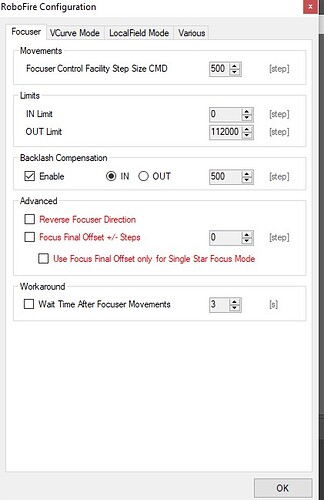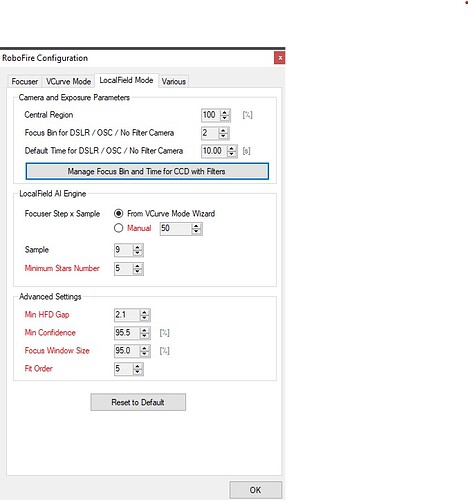Hello, someone is running the Optec-Leo Focuser together with Voyager. I can’t get along with the autofocus setup. Thanks and greetings from Enrico
Hi Enrico,
Voyager works with all focusers having ASCOM driver and that are developed in absolute mode(pratically all). Default settings works in 90% of cases out of the box. From them message isn’t clear what is your problem also because settings depends all from telescope and not from focuser (travel lenght apart).
We do not offer official support by forum and kindly invite you to ask for official support.
All the best
Leonardo
Hey Enrico,
I have the optec leo paired to my EdgeHD 9.25 SCT, and have got it working with Voyager. The initial setup was a bit more challenging to setup compared to using a focuser on a smaller refractor. I will remote into my pc which has the profile and see what I did.
What scope are you using with it ?
Hello, thank you. I have an Edge HD1100 - mostly with a 0.7 reducer. Unfortunately I’m still waiting for my mount. If you could send me your settings, it would be really great. I had already tried to set up the auto cous in Voyager with the ZWO EAF - but unfortunately without success. Was spoiled by the ZWO Asiair PRO, where you didn’t have to adjust anything ;-). But now I had to switch to the LEO because of the stability. Greetings Enrico and a nice weekend
I am using the .7 reducer as well. I think I got the auto-focus setup for both ways, with and without the reducer. For reference, before voyager, I was using SGP. So first I tested out the focuser in SGP, and I had to use step size of 3000 in sgp to get it working. One thing I made sure was to manually focus on a bright star using a bhatinov mask in Sharpcap by zooming in, before doing the setup in Voyager
BTW the Optec Leo is an awesome, well machined focuser.
Many Thanks. Do you have a screenshot of the Voyager autofocus settings for me? I hope that my mount will come soon and that I can finally get started again  Greetings Enrico
Greetings Enrico
So if I recall, here are the steps I followed.
1.) Manually center and focus on a star using bhatinov mask.
2) See my current Robofire configuration settings.
3) Using the setting above, I ran Vcurve Frist Light Wizard.
Robofire Focuser Setting
VCurve Mode Setting. (I did not enter the vcurve parameter. The first light wizard added those)
LocalField Mode
The Leo should not have any backlash.
super very very tanks!
Attention !!
The exposure parameters in the attached image are not correct, too much longer exposure.
Please use default, if you are using a CMOS camera higher the default gain if you experience low signal on star and adjust the flux. Remember to select the right magnitude interval for star for each filters.
Remember also to use the green button in RoboFire Management to point the closest right focus star before do any operations like first light wizard, adding vcurve, testing autofocus
This is one of reason for I ask users to contact directly support for this kind of task.
All the best
Leonardo
Ahh good to know. I will reset my settings and try again. With my 9.25, I had issues with using the green button to point to the closest right focus star. But will go through the routine one more time. If unsuccessful, will open support ticket. Thanks Leo
This is strange because, green button just do a simple goto wihtout solving
On my Esprit100 refractor it was simple and worked with the default settings. But with the longer focal length of 9.25, things get more complicated
Using long focal lengths with small pixels involves knowing how the devices work in order to tune them.
Usually whats happens is the flux increase because high resolution spread the star pixel in a bigger area.
When you want to go towards something complicated you need to know how to move between hardware and software, even asking for support if your knowledge is not adequate. It’s a hobby but it can still get really complicated.
Hello Leonardo,
first of all thank you very much for your quick answers in your free time. I really appreciate that. I understood the problem of oversampling quite well. My problem is not wanting to buy another camera again. One with 9 µm would be ideal here. The Atik camera 11000 Mono would fit well, but is no longer available. I will now try to get the maximum out of my ASI6200mm first. The 10 micron mount that is due to come in February will certainly serve me well. I wish you a good Sunday and especially good health these days.
Greetings Enrico
Hi Enrico,
you are welcome. My suggestion is to use at least binning2 with that camera.
The helps to get a reasonable oversampling and have a margin for guiding.
At 0.4"/pixel of resolution in bin1 I will never attempt from Europe.
All the best
Leonardo
The “hardware” BIN2 of the camera is unfortunately more of a pixel skip (because of the CMOS camera). I don’k think that’s so good. I will now look for a good software solution.
Hardware bin2 work really fine with your camera so you can use without problems.
Data must be received by automation software already binned to prevent effect of too much oversampled system.
All the best
Leonardo
That would be very good news. Just to be on the safe side: I have an ASI6200mm CMOS camera? So it is better to use the BIN2 of the camera (mind you a CMOS camera) than a software BIN2 afterwards?
Yes, in your case absolutely.


